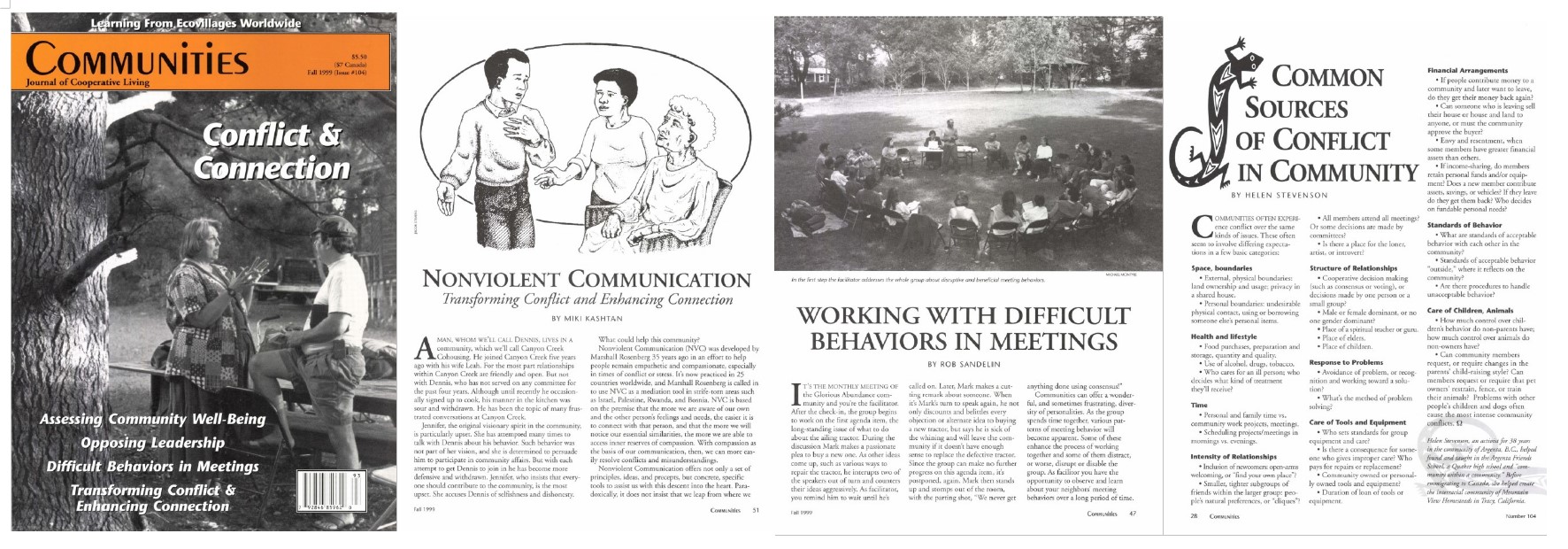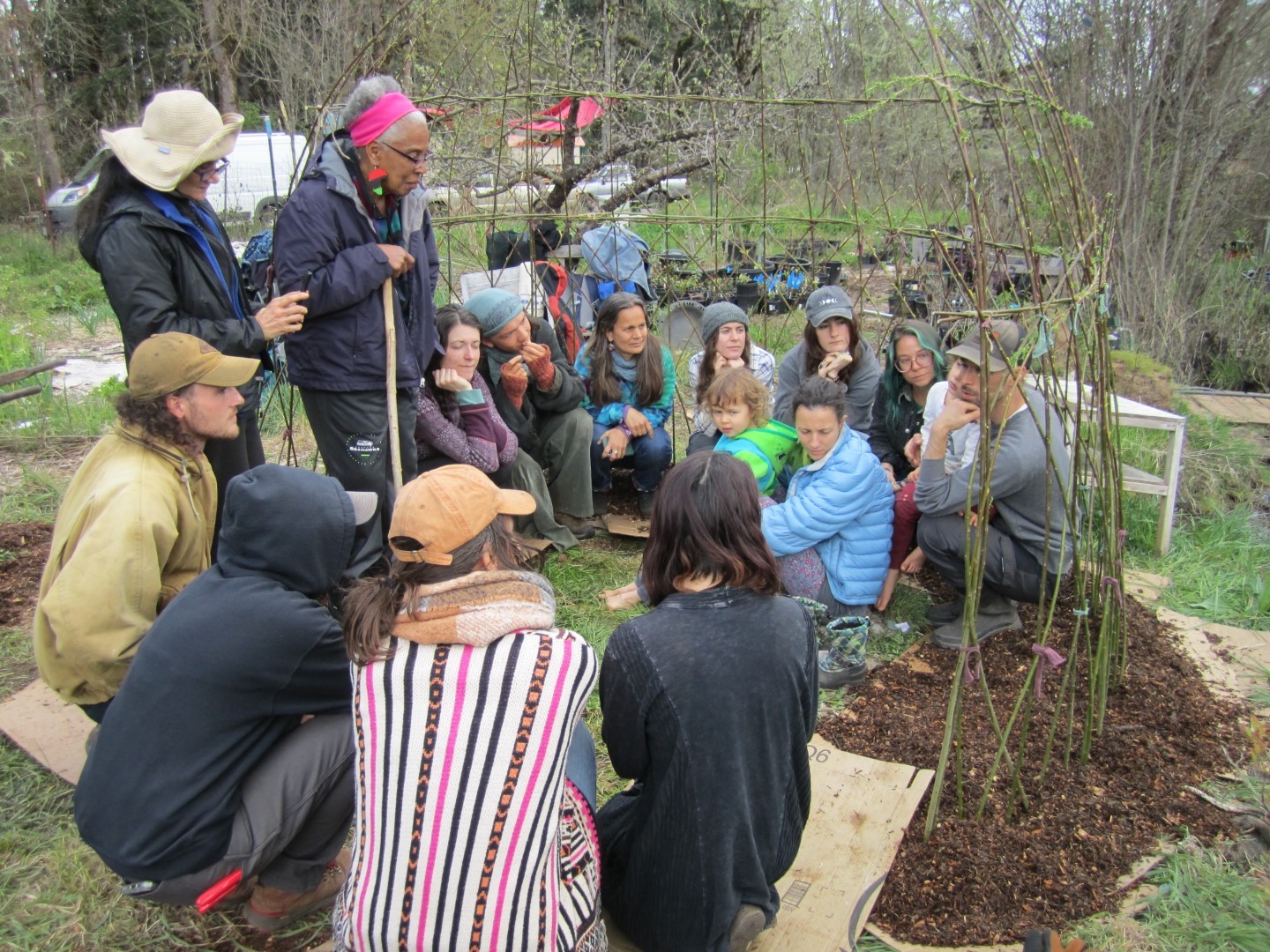By Chris Roth

(excerpted from Communities #203, Summer 2024)
Readers who were with us in the last millennium, or who’ve visited their online account to peruse the digital back issue archive, may recognize something that we didn’t until we’d already announced this issue’s theme: that it exactly duplicates that of Communities #104, published in Fall 1999. This turns out to be both a coincidence, and no surprise to us. “Conflict and Connection” was as timely a theme 25 years ago as it is today and likely will be in 25 years.
We establish each new theme in response to what seems relevant in the present moment, rather than looking to past issues. In fact, in assembling this issue, I consciously decided NOT to delve into that past one at all, lest it compromise the organic unfolding of this one.
Nevertheless, it often seems that everything old is new again. With this issue’s material complete, I’ve surveyed #104 and can safely say that while much has changed outwardly in the past 25 years, little has changed in the core experience of community as reported in our pages. Countless theme elements in this issue echo those addressed in that issue: Nonviolent Communication; other practices to address conflict head-on and increase community connection; experiences of loss of community when conflict wasn’t handled well and/or when interpersonal connection was not prioritized; the idea (highlighted as a pull quote on page 48 of issue #104, then again by that issue’s editor in a letter on page 4 of this one) that it’s important to “Focus on ‘disruptive meeting behaviors’ rather than ‘disruptive people’”; and more.
The themes are old, but the stories are new. And fortunately, new territory is explored as well, and some old territory explored more deeply and/or from different angles. Yet surveying the two issues together gives the distinct impression of a single journey.
● ● ●

One of my greatest pleasures as editor is to receive stories that so closely match my own experiences—albeit with different characters and some different details—that I feel zero need to write anything original about those myself. (This is true of several stories in this issue.) In the same way, one of the greatest pleasures I feel in community meetings is to notice that it is often not necessary for me to be the one to articulate a particular personal truth, viewpoint, impression, idea—someone has just said what I was going to say, and all that’s left is to concur and appreciate what they said. And sometimes it’s my turn to say the thing first, and discover that some others resonate too, or at least appreciate the contribution.
These phenomena provide a visceral experience of the connection that functional communities embody—the feeling of being part of an organism in which we all play our own roles but none are isolated, and in which we arrive where we’re going together, not apart. We are far more intertwined than the individualistic worldviews many of us have grown up with would lead us to believe. Finding our voices in one another, and in relation to one another, is just one way that interconnection manifests.
This helps recast the idea of “conflict” from a confrontation of distinct, opposing parties to one in which we are part of the same conversation, the same larger organism, trying to rebalance ourselves and to find a way forward, having encountered a bump in the road or perhaps a major washout. That conversation often brings us closer, revealing elements that may be buried most of the time in more superficial interactions. It may also, of course, reveal that it’s time to go our separate ways.
As numerous authors herein describe, conflict and connection are not opposites. The first, conflict, is inevitable—not only outwardly, in every group, but internally, within all but the rarest individual. The second, connection, is the outcome when the first is handled as a learning and growth opportunity—regarded as a gift (even if not one we’ve requested) that can lead us to better understanding, effectiveness, cohesion, boundaries, openness, and ultimately love.
● ● ●

Just as some of our themes are perennial, the insights they generate are perennial too—although their truth may be experienced more deeply as the years pass. As I contemplated some of the articles in this issue, I remembered a song written more than 30 years ago by a folksinger-songwriter then in her mid-20s, who had lived recently in an intentional community.
The printed page cannot convey the effects of the beautiful finger-picked guitar nor the melody—and this song, “The Reflection,” from Laura Kemp’s first album, “I Hope They Like the Rain,” was issued only on cassette tape. It’s a hidden gem currently existing only on frequent play in my mind, and in the collections of those few lucky enough to have it in recorded form. * UPDATE: With Laura’s permission, we are posting an mp3 of the song below: *
I share the lyrics here nonetheless, because they encapsulate universal truths also discovered in community when one pays attention:
So it seems I’ve been surrounded
By all these mirrors facing me
And every bone I thought I buried deep
Has surfaced to the ground for all to see
Every face is my reflection
Every criticism is of myself
Now is the time to learn acceptance
And lay down these judgments on the shelf
And as I come to know you
I’ll understand more and more about me
How I want to love you
And see a lightning storm through your eyes
And feel the rain approaching in the breeze
I was still a relative novice to intentional community living when I first heard “The Reflection.” Its lyrics mean so much more to me now than they did then, thanks to decades of experiencing that kind of mirroring in community, and finding that the ultimate result of our honesty in confronting head-on whatever comes up between or among us, rather than hiding from it, is a falling-in-love with one another that could never have happened if we’d stayed in our private, walled-off realities.
That kind of love often brings equally expansive, related feelings…a sense of wonder, a greater sensitivity to the world we are living in, even a deeper experience of the “ecological self.”
● ● ●
Of course, not every conflict is the result of people becoming mirrors (often uncomfortable) to one another. A conflict can arise from stimulation of past traumas, when behavior and attitudes unique to one party reactivate pain in the other. It can arise from present stimulation of pain or distress, with no past experience required. It can arise simply from the identification of “toxic” energy that will hobble the community without the establishment of good boundaries—even if we see nothing of ourselves in the person appearing to carry that energy. And it can arise from different, legitimate viewpoints, disagreements about strategy, diverging aesthetic tastes, and a host of other factors seemingly divorced from our personal relationships with one another or with ourselves.
But no matter the particulars, finding what connects us with one another allows us to deal with every conflict more easily. Coming from the other direction, healthy approaches to conflict also lead us into ever-deeper connection with one another, where our potential for love, wonder, and greater attunement to the wider-than-human world can be realized and celebrated.
In the words of one rather famous advocate of effective collectivism: in our attitudes and approaches toward conflict, many of us have nothing to lose but our chains.

Communities editor Chris Roth is a long-time member of Lost Valley/Meadowsong outside Dexter, Oregon (lostvalley.org), and an even longer-time fan and friend of songwriter Laura Kemp (laurakemp.com), who did NOT put him up to this.
